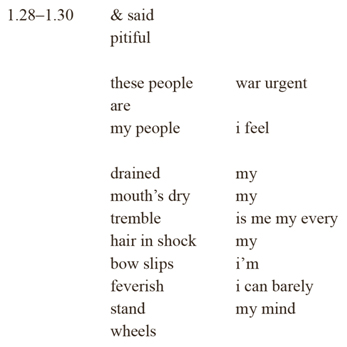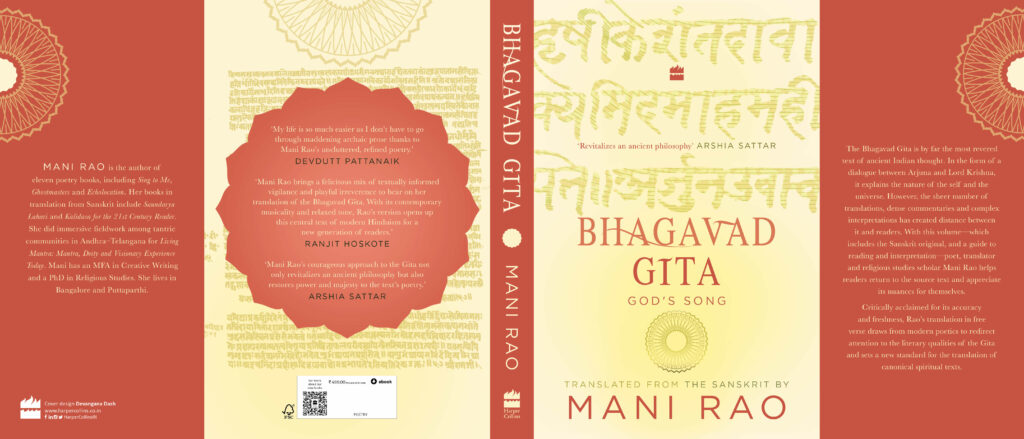Since the first translation of the Bhagavad Gita in 1789 by Charles Wilkins, there have been hundreds of translations into English. Some have translated the poetry of the Gita into prose, and some others have attempted metrical poetry. Whereas prose translations do not convey the delights of the original, good metrical translations have no choice but to compromise on fidelity. This is also why commentaries exist, but, they tend to be loaded with terminology and digressions, and however useful, deter the eager reader from a continuous reading of the text.
Reading the Gita is a happy afternoon project for a reader who knows Sanskrit; for reader who does not know Sanskrit, old-style translations may not offer the same easy reading speed. The Gita is a teaching, it is not a pedantic text. Thought-provoking wordplay, connections and associations between words, and implied meanings are present throughout the seven hundred verses. Sometimes, the meaning is adequately conveyed only when you take in the suggestiveness and resonance (dhvani), characteristics of memorable poetry.
As languages, Sanskrit and English are different from each other— not just in terms of the conceptual worlds they rise from and refer to, but also in their linguistic structures, their ‘deep grammar.’ Sanskrit nouns are declined, and thus, have case endings; therefore, in a sentence, the parts of speech are made clear within the words. A simple example—in the sentence “A girl goes to school”, “girl” is the subject, and “school” is the object. In Sanskrit, the noun “girl” will be in the nominative case (prathamā vibhakti), and the noun “school” will be in the accusative case (dvitīyā vibhakti). Therefore, we may structure the sentence any which way, including “to school – goes – girl”. Now if all those components of the Sanskrit sentence (to school / girl / goes/) were written separately, in different corners of a single page, they would still make sense. In Sanskrit, we comprehend the words along with their roles in the sentence. In a Sanskrit stanza, then, what decides the sequence of words is rhythm, smoothness, or metrical considerations. This is also why when we read Sanskrit poetry, we may begin with analysing the “prose order” (anvaya, or connections). This involves a reordering of the words in the stanza in a way that becomes easier to follow.
Such structural freedom inherent in Sanskrit composition opens up possibilities in translation via contemporary poetics. Like science, poetics has also become more become more developed, and today there are more resources available to writers and readers. Poetry was once an oral art, and belonged to the dimension of time. Even though manuscripts and inscriptions were used, the dimension of space arrived into everyone’s daily lives through the printing press and the printed page. Translating ancient texts is also a translation from a temporal, to a temporal and spatial medium. The line, for example, does not need to hang on for life to the left margin. Spacing and connections are available to be used if they help understanding. Here is an example:

In my translation, the has been deconstructed into the components and relationships between them. The vedantic idea of “neti” (‘not this’) is imitated. i.e., how discarding reveals the true you. You discard and you discard (what you are not) and that is how you find out who you are. It is by discarding (whatever is intransient) that “you are”. The analogy between old clothes and the old worn-out body is stacked vertically, so it is a quick and easy connection upon the page.
At this stage, Krishna is only speaking about the nature of ātman– it is that which has the body. Readers will notice that Krishna does not tell Arjuna directly – “you are ātman.” Krishna explains the concept of ātman, and without saying so, lets Arjuna realize his identity with ātman. What occurs here is an identity shift, a point that is communicated without being spelt out. Hence, my translation uses vertical as well as horizontal space, and presents the sub-text vertically – “this is who you really are.” The reader can take it in visually, even as she continues to read the line.
On the other hand, if something is really emphatic in a text, it can be spatially demarcated from the other words in the verse. Here is another example from my translation:

Arjuna uses the verb “see” – (I see, paśyāmi) – in every single stanza from stanza 11.14 to 11.19 11.19. Noticing this makes one much more aware that what is being described is a spectacle and an extraordinary sight. This is not just a description of Krishna’s viśvarūpam (universal form) –- it is a description of viśvarūpa-darśaṇam (the vision of Krishna’s universal form). Hence, I extracted the verb “see” into a separate column, and relocated everything that was seen within its frame.
Here is another example how deconstruction helps bring out that Arjuna is full of himself when – having come all the way to the battlefield – he refuses to fight.

In particular in the Gita, Krishna takes ownership of everything in the universe. Reading the Sanskrit, one cannot but help notice the repetition of “asmi” (translates as “I Am”). In the translation, I AM is larger and dominates the space of the page to convey this.

_____________________________________________________________________________________________________________
The material on this webpage in relation to this book is included here by kind permission:
– in the case of the the cover, by the publisher, Harper Collins India; and,
– in the case of the text, by the publisher as well as the author, Mani Rao, the author of Bhagavad Gita: God’s Song (HarperCollins India, 2023)


